Ancient Grains – Millet and Quinoa
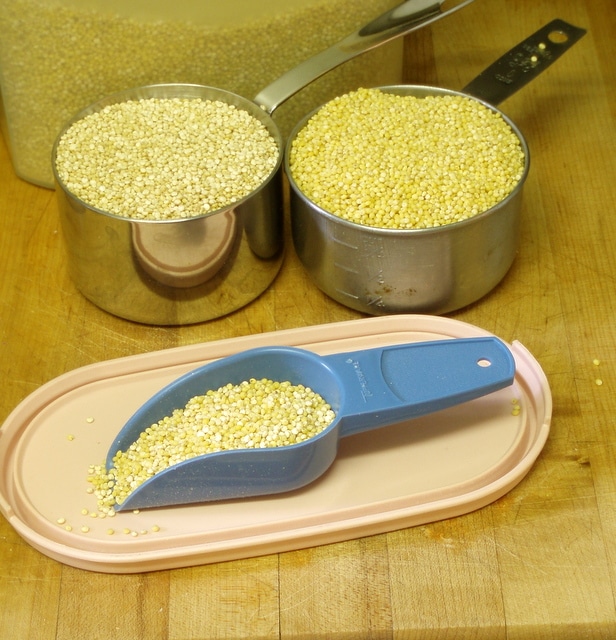
As whole grains go, millet and quinoa are fast food. They cook in 15-20 minutes – much faster than brown rice, and actually faster than white rice! I can walk into the kitchen, put on a pot of millet, and have it ready by the time the rest of the meal is cooked.
Millet and quinoa are grains from opposite ends of the world with some remarkably similar characteristics, so I’m discussing them at the same time. They are versatile. They work well as a side dish, as an ingredient in recipes, as a porridge. They are good hot or cold. They even combine well… I often combine them, as I think the milder millet and the more assertive quinoa complement each other well. (And it helps that millet is much less expensive than the currently trendy quinoa…) Also, they are both gluten free. While this is probably one reason that millet never took off all that well in the bread eating areas of Europe, now it means they are useful for people avoiding gluten. (Flour is available for gluten free baking, but I’m going to discuss here the uses of the whole, unground grains.)
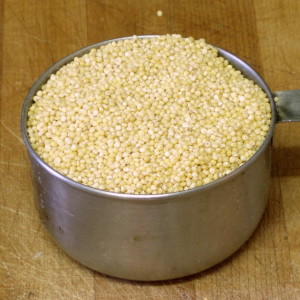 Millet is the older. It is thought that millet may have been the first grain ever domesticated – it is the oldest that archeologists currently have evidence of being farmed. There is evidence of millet being grown in Asia more than 8,000 years ago, and it has continued to be a staple in China and India, even as rice became more dominant. It gradually made its way into Europe a mere 7,000 years ago. Millet is drought resistant, which makes it especially valuable in India and Africa.
Millet is the older. It is thought that millet may have been the first grain ever domesticated – it is the oldest that archeologists currently have evidence of being farmed. There is evidence of millet being grown in Asia more than 8,000 years ago, and it has continued to be a staple in China and India, even as rice became more dominant. It gradually made its way into Europe a mere 7,000 years ago. Millet is drought resistant, which makes it especially valuable in India and Africa.
I first ate it years ago, before I was quite as totally an eater of whole grains… I thought it was OK, but it seemed a bit bland to me… and it was, at the time, very hard to get where I lived. I could cook (equally bland) white rice with the same speed, so I really didn’t see any advantage worth making a special trip to a Health Food Store (as we called them then.) So I ate it irregularly, only if I happened to notice it. Once I left white rice behind, though, it was more attractive.
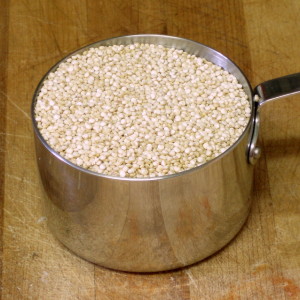 Quinoa is more recent – both in fact and in my awareness. It originated in the Andes, in South America, and appears to have been domesticated nearly 4,000 years ago. It has only really become readily available outside of South America in the late 20th century, and popular in the last 10-15 years. And in the last couple of years, as it has become even more popular (not to mention trendy,) the price has skyrocketed.
Quinoa is more recent – both in fact and in my awareness. It originated in the Andes, in South America, and appears to have been domesticated nearly 4,000 years ago. It has only really become readily available outside of South America in the late 20th century, and popular in the last 10-15 years. And in the last couple of years, as it has become even more popular (not to mention trendy,) the price has skyrocketed.
Unlike millet, it has a strong, assertive flavor. Improperly prepared, it can also taste bitter… the saponin that naturally coats the seeds must be washed off. (Most commercially available quinoa is prewashed – but I have found it best to rinse it again myself, to be sure…) Prepared correctly, though, it is delicious, and stands alone as a side dish with no sauce or other added flavoring better than many other grains, making it a good choice when you have a dish to serve next to, rather than over, your grain. The most readily available quinoa is white, but it also comes in red and black. Mixing several colors makes a very attractive presentation.
As I said, I often mix quinoa and millet, usually half and half, sometimes 1 part quinoa to 2 millet. I’ll even just mix them right in a storage container, sometimes, as you see in the picture above. The seeds are the same size and shape, and only the color differentiates them at a glance. I understand that millet, too, actually grows in several colors, but all that I’ve seen available is a warm light yellow, which is delicately pretty mixed with white quinoa – and downright striking mixed with red or black.
 Both grains are cooked with the same proportion of grain to water – 1:2. I find that if I cook one cup of grain with 2 cups of water I have 4 servings, for our taste. If I am cooking quinoa, alone or in a mix, I put it in a fine strainer and rinse it well under running water, then put it in a pot of cold water. (Millet can usually be put right in the pot – most packaged grains are already clean, and it doesn’t have the saponin issue.) Bring the water to a boil, lower the heat, and simmer for 15 minutes. Turn the heat off, even if there is still a little water left in the bottom of the pot, cover the pot, and let sit for 5 minutes. At that point you can either fluff it with a fork, allow the steam to escape, and give yourself a nice light fluffy grain – or press it together with the spoon to use in the same way you would sticky rice.
Both grains are cooked with the same proportion of grain to water – 1:2. I find that if I cook one cup of grain with 2 cups of water I have 4 servings, for our taste. If I am cooking quinoa, alone or in a mix, I put it in a fine strainer and rinse it well under running water, then put it in a pot of cold water. (Millet can usually be put right in the pot – most packaged grains are already clean, and it doesn’t have the saponin issue.) Bring the water to a boil, lower the heat, and simmer for 15 minutes. Turn the heat off, even if there is still a little water left in the bottom of the pot, cover the pot, and let sit for 5 minutes. At that point you can either fluff it with a fork, allow the steam to escape, and give yourself a nice light fluffy grain – or press it together with the spoon to use in the same way you would sticky rice.
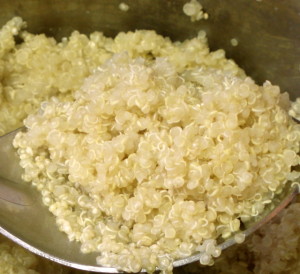 Now – look at this picture of cooked quinoa, with its characteristic stripe. That is normal, that is the way it will always look – and it can be a little startling if you are not expecting it… The little squiggly lines are the germ – the part that would grow if you planted it – and I have no idea why it looks different from any other grain or seed I’ve ever cooked, but there it is.
Now – look at this picture of cooked quinoa, with its characteristic stripe. That is normal, that is the way it will always look – and it can be a little startling if you are not expecting it… The little squiggly lines are the germ – the part that would grow if you planted it – and I have no idea why it looks different from any other grain or seed I’ve ever cooked, but there it is.
Leftovers keep well for 2-3 days in the refrigerator, and microwave well. Or you can reheat them with water or broth to make a moister porridge – nice for breakfast.
They’re great transition grains, if you want to move to more whole grains in your diet. The speed of cooking really helps the cook, of course. And people aren’t used to a refined version of them, so may be more willing to accept them than the whole grain version of a food they already know. Try millet instead of white rice with a curry, or quinoa (with a pat of butter, or some gravy) next to pork chops instead of mashed potatoes.
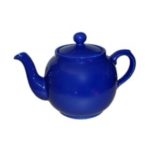
I have never tried millet! I may have to- mixing it with quinoa sounds good too. My favorite grain might be bulgur.. I love the texture!
The texture is actually pretty close to bulgur wheat, and I have a friend who substitutes quinoa for bulgar in tabbouleh. (I’d rather use millet for that, myself, if I were to substitute, because of the flavor.) Do try it, I think you would like it.
The next planned Grains post will be about wheat, actually, and I’ll be talking about bulgur! People are just used to bread and pasta – and there is so much more that can be done with that versatile grain.
Right, I need to vary my grain intake more and this shows I have no excuse! Thanks for linking up to #recipeoftheweek – sorry I’m a bit late over! Have Pinned this post and scheduled in a tweet. New linky just went live for this week 🙂 x
I am not sure how accurate it is, but many types of grains are called “millets” in India! Some varieties are foxtail millet, barnyard millet, sorghum millet (jowar), pearl millet/bulgur (bajra), ragi millet, little millet, kodo millet, and probably a few more I am forgetting. Of these jowar, bajra, and ragi are extremely popular in the west and south west states – which have a dry climate, fewer rivers, and face frequent droughts.